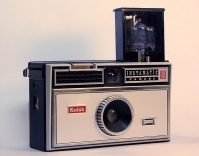Kodak Instamatic 100
In 1963, Kodak introduced its Instamatic 100 camera designed by Frank A. Zagara of Kodak staff. It could be loaded with film cartridges ready to shoot. Price was $15.95. The Instamatic won a Certificate of Design Merit from the Industrial Designers Institute, and was produced until 1966. Kodak cameras have been around since 1888, when George Eastman (1854-1932) invented his original camera and founded the Eastman Dry Plate Company. When the camera's film pack was used, it was sent back to the factory for development of the photos. In 1889, celluloid was. modified by a Kodak chemist, Henry Reichenback, into photographic film which could be made into rolls. Eastman's 1895 "Pocket Kodak" camera and 1897 "Folding Pocket Kodak" set the typeform for all roll film cameras, and his $1.00 "Brownie" box camera of 1900 popularized home cameras. The "Brownie" got its name from Eastman''s first designer, Frank Brownell, who made all wooden camera parts for Eastman until 1902. Eastman's best known designer was Walter Dorwin Teague--Eastman was his first client in 1928. Teague designed the 1934 "Baby Brownie", which also sold at $1.00. Eastman Kodak introduced 35mm film in 1935, Kodachrome film in 1936, and Kodacolor film (for prints) in 1944. In 1945, Kodak established its own design department, headed by Theodore Clement working as assistant to Teague, who continued as a consultant. Clement soon added Arthur Crapsey, Jr., and later, Fred Knowles and Ken Van Dyke, as employees. In 1964, Kodak introduced a low-profile Model 800 Carousel slide projector, designed by David E. Hansen of Kodak staff headed by Arthur Crapsey, Jr. An earlier Model 550, somewhat bulkier and designed by Richard Olson of Kodak's staff, appeared in 1961. The Model 800 was produced through 1972 and established the typeform for projectors for the rest of the century. A Pocket Instamatic series of cameras, designed by staff, were introduced in 1972 by Eastman Kodak Company. It used a newly developed small 110-size film cartridge. In 1987, Kodak's new single-use Fling camera repeated history. The entire camera was sent back in for processing, just like Eastman's original 1888 camera. Cost: $6.95. An in 1993, a camera and film to be developed digitally and stored on CD-ROM was introduced by Kodak.
